Evaluation and Optimization of a Cross-Rib Micro-Channel Heat Sink
Abstract
:1. Introduction
2. Geometrical Model and Method
2.1. Geometrical Model
2.2. Numerical Model and Parameter Definition
2.3. Meshing Independence and Validation
2.4. Setup and Boundary Conditions
- The inlet adopted velocity-inlet flow rate was 2 m/s;
- The heat flux of the TTC was 100 w/cm2;
- The material of fluid was water (0.6 W/m·K), the material of TTC was Si (148 W/m·K), the material of micro-channel was Al (202.2 W/m·K), and the thermal conductivity of Tim was 5 W/m·K;
- In the adopted pressure-outlet, the pressure was set to atmospheric pressure.
3. Result and Discussion
3.1. Effect of Ribs
3.2. Effect of Aspect Ratio λ on Heat Dissipation Performance
4. Parameter Optimization
4.1. The Inclination Angle (α) of the Cross-Ribs
4.2. The Spacing (S) of the Cross-Rib
4.3. Effect of ribs in Same Pressure Drop
5. Conclusions
- (1)
- Compared with MC-R, the heat dissipation performance of MC-CR increased by 28.6%, and the pressure drop increased by 10.7-fold. Comparing with MC-HR, which has the same liquid–solid contact area, the heat dissipation performance increased by 14.3%. Therefore, the effects of fluid disturbance and contact area on the heat dissipation performance of MC-CR are equal;
- (2)
- Increasing the aspect ratio will increase the liquid–solid contact area, which is conducive to improving the heat dissipation performance. However, for MC-R, the thickness of the ribs will also change with the aspect ratio. Therefore, in the condition with constant Hc, the heat dissipation performance is inversely proportional to the aspect ratio; when the Wc is constant, the heat dissipation performance is proportional to the aspect ratio;
- (3)
- As the inclination angle, α, decreases, the average temperature rises by 5.7% overall, although the overall pressure drop is reduced by 97%. Meanwhile, the heat dissipation performance deteriorates by 5.6%, and the pressure drop is reduced by 86.3% as the spacing, S, increases. The heat dissipation performance is increased by 6.6%, and the pressure drop is reduced by 78.7% with the spacing, S, increases. In the condition where α = 30°, S = 0.1 mm, and λ = 4, the pressure drop is 4.5 kPa;
- (4)
- With the same pressure drop, the cooling performance of MC-CR increased by 14.25%, and the convection heat transfer coefficient increased by 2.27-fold compared with MC-R. The cooling performance of MC-CR increased by 10.51%, and the convection heat transfer coefficient increased by 2.3-fold compared with MC-SR.
Author Contributions
Funding
Data Availability Statement
Conflicts of Interest
References
- Laguna, G.; Vilarrubí, M.; Ibañez, M.; Betancourt, Y.; Illa, J.; Azarkish, H.; Amnache, A.; Collin, L.M.; Coudrain, P.; Fréchette, L.; et al. Numerical parametric study of a hotspot-targeted microfluidic cooling array for microelectronics. Appl. Therm. Eng. 2018, 144, 71–80. [Google Scholar] [CrossRef]
- Bailey, C. Thermal management technologies for electronic packaging: Current capabilities and future challenges for modelling tools. In Proceedings of the 10th Electronics Packaging Technology Conference, Singapore, 9–12 December 2008; pp. 527–532. [Google Scholar]
- Krishnan, S.; Garimella, S.V.; Chrysler, G.M.; Mahajan, R.V. Towards a Thermal Moore’s Law. IEEE Trans. Adv. Packag. 2007, 30, 462–474. [Google Scholar] [CrossRef] [Green Version]
- Xie, G.; Sundén, B.; Wang, L.; Utriainen, E. Parametric study on heat transfer enhancement and pressure drop of an internal blade tip-wall with pin-fin arrays. Heat Mass Transf. 2011, 47, 45–57. [Google Scholar] [CrossRef]
- Guan, N.; Liu, Z.-G.; Zhang, C.-W. Numerical investigation on heat transfer of liquid flow at low Reynolds number in micro-cylinder-groups. Heat Mass Transf. 2012, 48, 1141–1153. [Google Scholar] [CrossRef]
- Sauciuc, L.; Chrysler, G.; Mahajan, R.; Szleper, M. Air-cooling Extension-Performance Limits for Processor cooling applicatioins. In Proceedings of the 19th Annual IEEE Semiconductor Thermal Measurement and Management Symposium, San Jose, CA, USA, 11–13 March 2003; pp. 74–81. [Google Scholar]
- Tuckerman, D.F.; Pease, R.F.W. High-Performance heat sinking for VLSI. IEEE Electron Device Lett. 1981, 2, 126–129. [Google Scholar] [CrossRef]
- Rajalingam, A.; Chakraborty, S. Effect of micro-structures in a microchannel heat sink—A comprehensive study. Int. J. Heat Mass Transf. 2020, 154, 119617. [Google Scholar]
- Zhang, B.-C.; Li, Q.-L.; Wang, Y.; Zhang, J.-Q.; Song, J.; Zhuang, F.-C. Experimental investigation of nitrogen flow boiling heat transfer in a single mini-channel. J. Zhejiang Univ. A 2020, 21, 147–166. [Google Scholar] [CrossRef]
- Wang, H.; Chen, Z.; Gao, J. Influence of geometric parameters on flow and heat transfer performance of micro-channel heat sinks. Appl. Therm. Eng. 2016, 107, 870–879. [Google Scholar] [CrossRef]
- Lin, L.; Zhao, J.; Lu, G.; Wang, X.-D.; Yan, W.-M. Heat transfer enhancement in microchannel heat sink by wavy channel with changing wavelength/amplitude. Int. J. Therm. Sci. 2017, 118, 423–434. [Google Scholar] [CrossRef]
- Park, M.-C.; Ma, S.-B.; Kim, K.-Y. Optimization of a Wavy Microchannel Heat Sink with Grooves. Processes 2021, 9, 373. [Google Scholar] [CrossRef]
- Hung, T.C.; Huang, Y.X.; Yan, W.M. Thermal performance of porous microchannel heat sink: Effects of enlarging channel outlet. Int. Commun. Heat Mass Tranf. 2013, 48, 86–92. [Google Scholar] [CrossRef]
- Ghani, I.; Sidik, N.A.C.; Mamat, R.; Najafi, G.; Ken, T.L.; Asako, Y.; Japar, W.M.A.A. Heat transfer enhancement in microchannel heat sink using hybrid technique of ribs and secondary channels. Int. J. Heat Mass Transf. 2017, 114, 640–655. [Google Scholar] [CrossRef]
- Chai, L.; Xia, G.D.; Wang, H.S. Parametric study on thermal and hydraulic characteristics of laminar flow in microchannel heat sink with fan-shaped ribs on sidewalls e Part 3: Performance evaluation. Int. J. Heat Mass Transf. 2016, 97, 1091–1101. [Google Scholar] [CrossRef]
- Chai, L.; Xia, G.D.; Wang, H.S. Parametric study on thermal and hydraulic characteristics of laminar flow in microchannel heat sink with fan-shaped ribs on sidewalls e Part 1: Heat transfer. Int. J. Heat Mass Transf. 2016, 97, 1069–1080. [Google Scholar] [CrossRef]
- Chai, L.; Xia, G.D.; Wang, H.S. Parametric study on thermal and hydraulic characteristics of laminar flow in microchannel heat sink with fan-shaped ribs on sidewalls e Part 2: Pressure drop. Int. J. Heat Mass Transf. 2016, 97, 1081–1090. [Google Scholar] [CrossRef]
- Chai, L.; Xia, G.D.; Wang, H.S. Numerical study of laminar flow and heat transfer in microchannel heat sink with offset ribs on sidewalls. Appl. Therm. Eng. 2016, 92, 32–41. [Google Scholar] [CrossRef]
- Chai, L.; Wang, L.; Bai, X. Thermohydraulic performance of microchannel heat sinks with triangular ribs on sidewalls e Part 1: Local fluid flow and heat transfer characteristics. Int. J. Heat Mass Transf. 2018, 127, 1124–1137. [Google Scholar] [CrossRef]
- Chai, L.; Wang, L.; Bai, X. Thermohydraulic performance of microchannel heat sinks with triangular ribs on sidewalls e Part 2: Average fluid flow and heat transfer characteristics. Int. J. Heat Mass Transf. 2019, 128, 634–648. [Google Scholar] [CrossRef]
- Xie, G.-F.; Zhao, L.; Dong, Y.-Y.; Li, Y.-G.; Zhang, S.-L.; Yang, C. Hydraulic and Thermal Performance of Microchannel Heat Sink Inserted with Pin Fins. Micromachines 2021, 12, 245. [Google Scholar] [CrossRef]
- Deng, D.; Pi, G.; Zhang, W.; Wang, P.; Fu, T. Numerical Study of Double-Layered Microchannel Heat Sinks with Different Cross-Sectional Shapes. Entropy 2019, 21, 16. [Google Scholar] [CrossRef] [Green Version]
- Nonino, C.; Savino, S. Temperature Uniformity in Cross-Flow Double-Layered Microchannel Heat Sinks. Fluids 2020, 5, 143. [Google Scholar] [CrossRef]
- Jing, D.; He, L. Thermal Characteristics of Staggered Double-Layer Microchannel Heat Sink. Entropy 2018, 20, 537. [Google Scholar] [CrossRef] [Green Version]
- Zhang, F.; Wu, B.; Du, B. Heat transfer optimization based on finned microchannel heat sink. Int. J. Therm. Sci. 2021, 172, 107357. [Google Scholar] [CrossRef]
- Sui, Y.; Lee, P.; Teo, C. An experimental study of flow friction and heat transfer in wavy microchannels with rectangular cross section. Int. J. Therm. Sci. 2011, 50, 2473–2482. [Google Scholar] [CrossRef]
- Khan, M.Z.U.; Uddin, E.; Akbar, B.; Akram, N.; Naqvi, A.A.; Sajid, M.; Ali, Z.; Younis, M.Y.; García Márquez, F.P. Investigation of Heat Transfer and Pressure Drop in Microchannel Heat Sink Using Al2O3 and ZrO2 Nanofluids. Nanomaterials 2020, 10, 1796. [Google Scholar] [CrossRef] [PubMed]
- Wang, S.-L.; Zhu, J.-F.; An, D.; Zhang, B.-X.; Chen, L.-Y.; Yang, Y.-R.; Zheng, S.-F.; Wang, X.-D. Heat transfer enhancement of symmetric and parallel wavy microchannel heat sinks with secondary branch design. Int. J. Therm. Sci. 2021, 171, 107229. [Google Scholar] [CrossRef]
- Ansari, D.; Husain, A.; Kim, K.-Y. Multiobjective Optimization of a Grooved Micro-Channel Heat Sink. IEEE Trans. Components Packag. Technol. 2010, 33, 767–776. [Google Scholar] [CrossRef]
- Qu, W.; Mudawar, I. Experimental and numerical study of pressure drop and heat transfer in a single-phase micro-channel heat sink. Int. J. Heat Mass Transf. 2002, 45, 2549–2565. [Google Scholar] [CrossRef]
- Kestin, J.; Sokolov, M.; Wakeham, W.A. Viscosity of liquid water in the range −8 °C to 150 °C. J. Phys. Chem. Ref. Data 1978, 7, 941–948. [Google Scholar] [CrossRef] [Green Version]
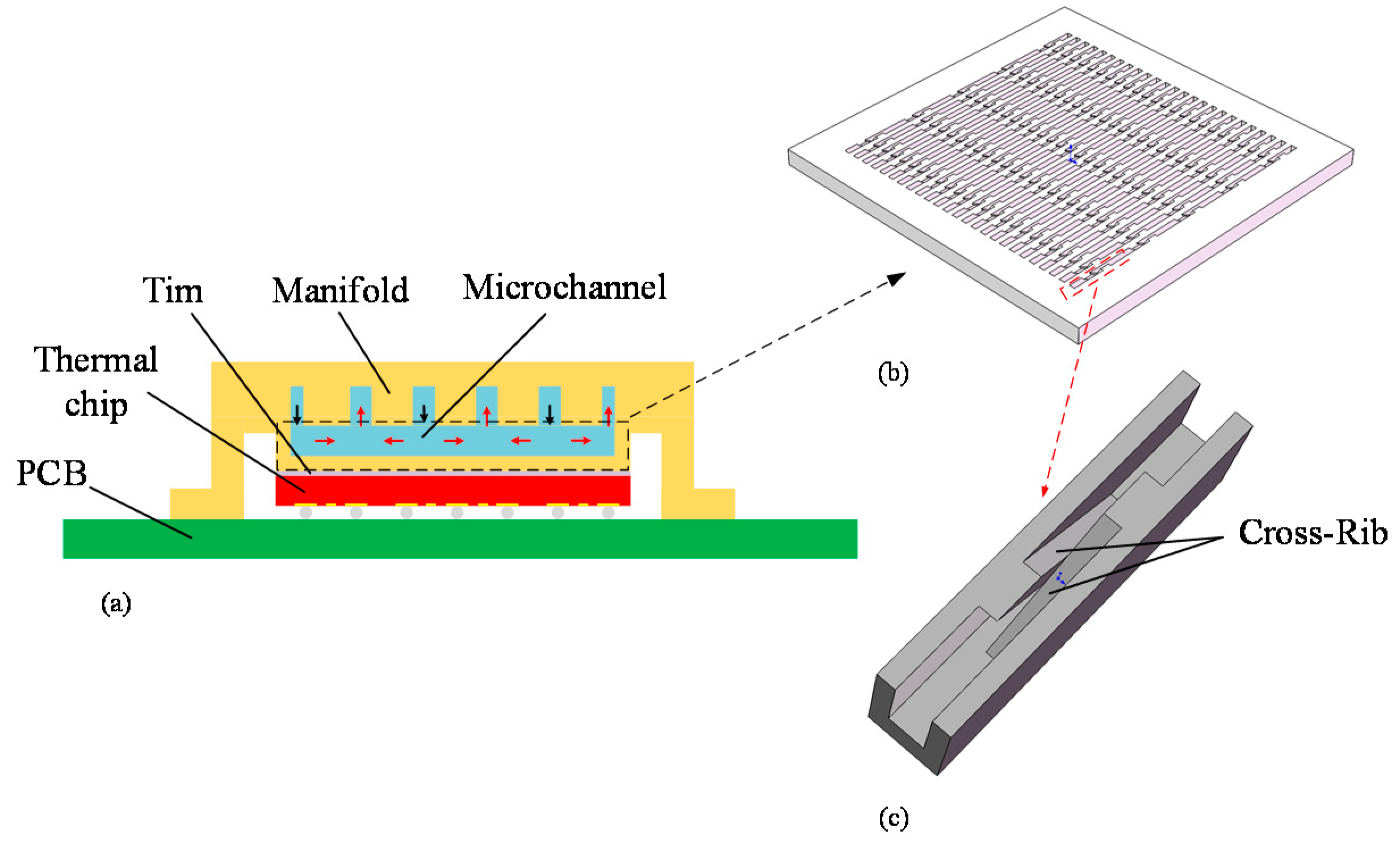

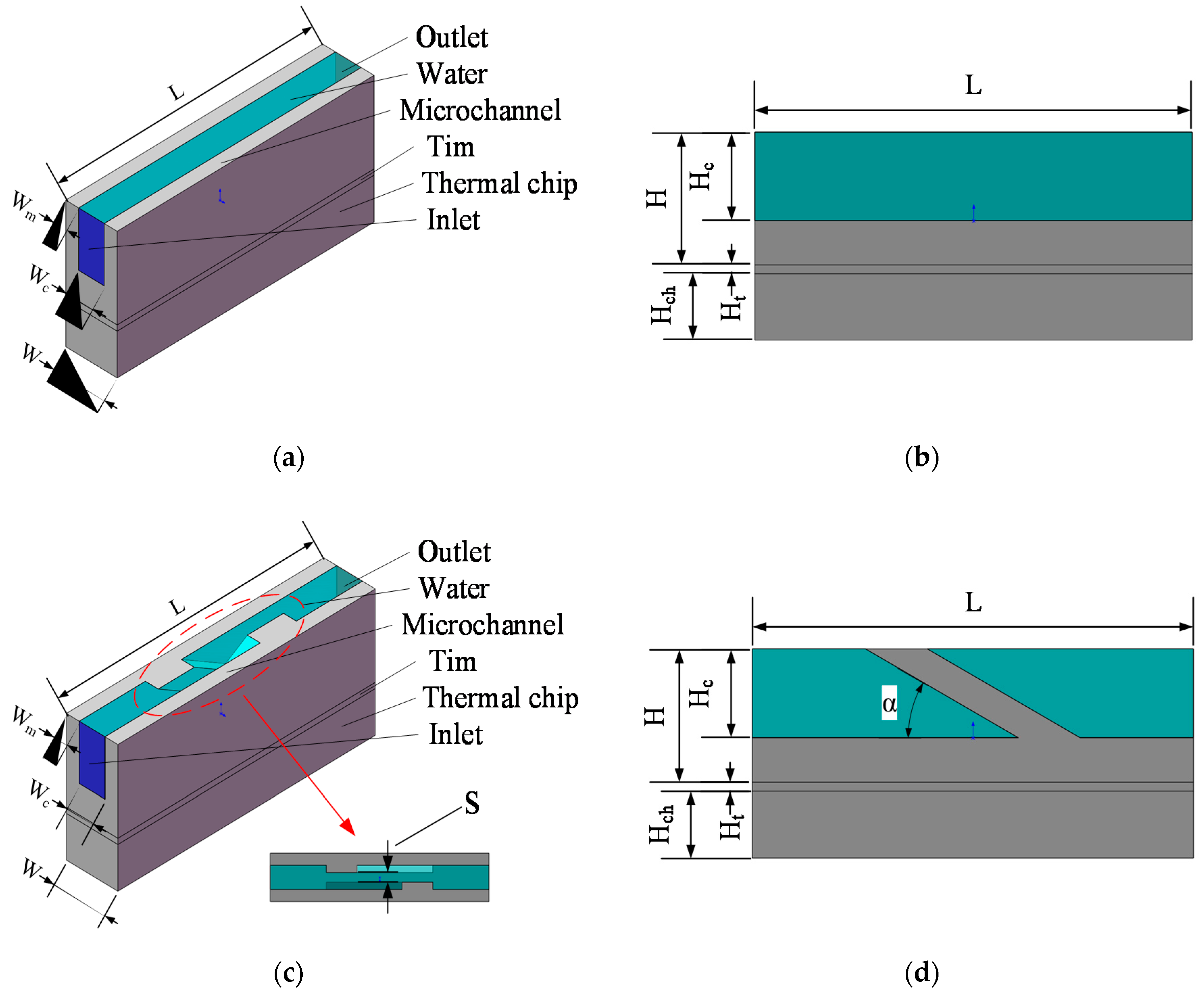
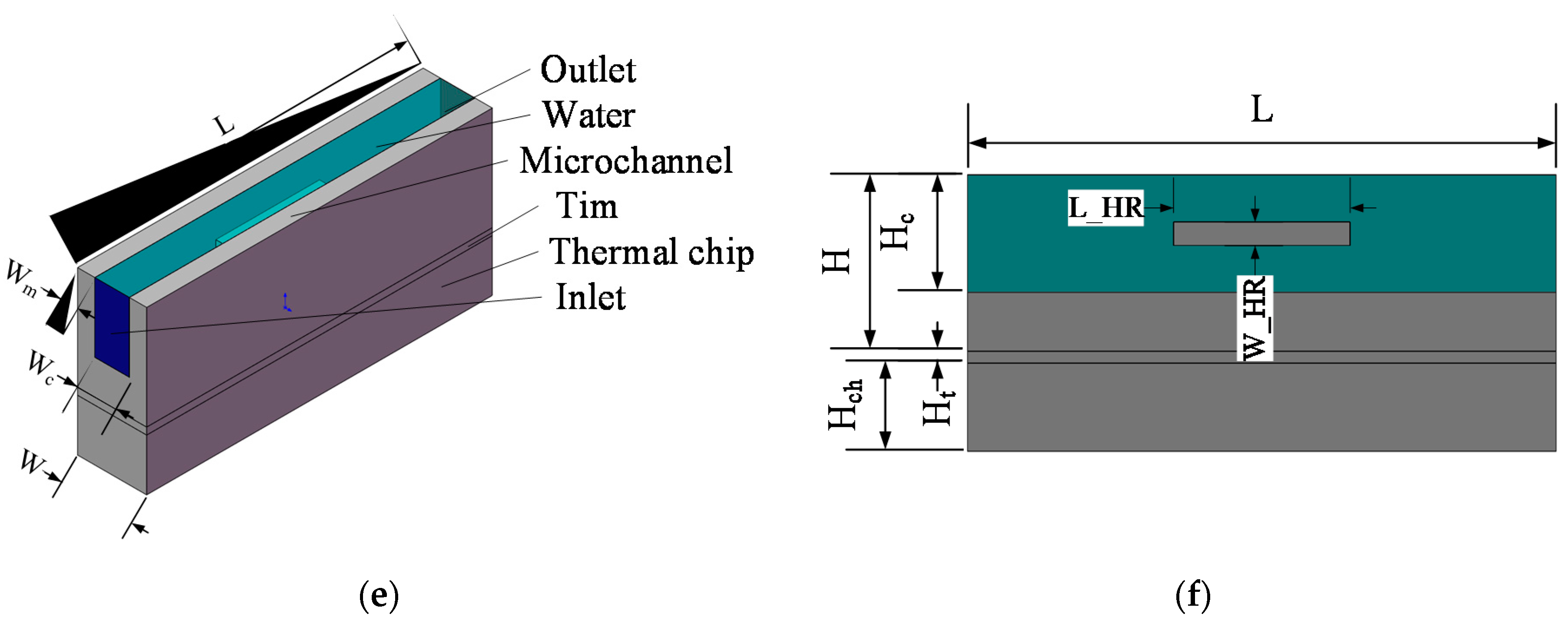
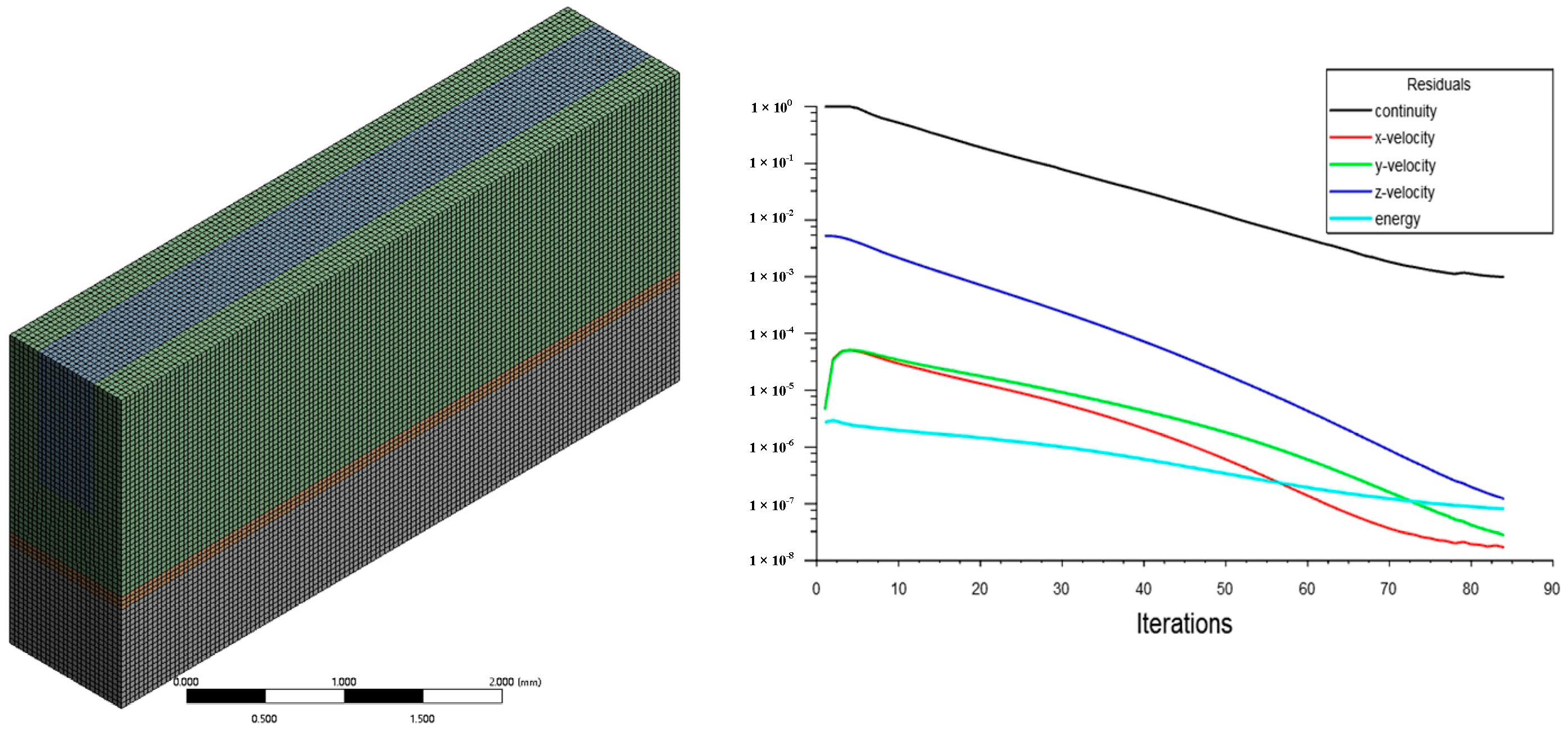
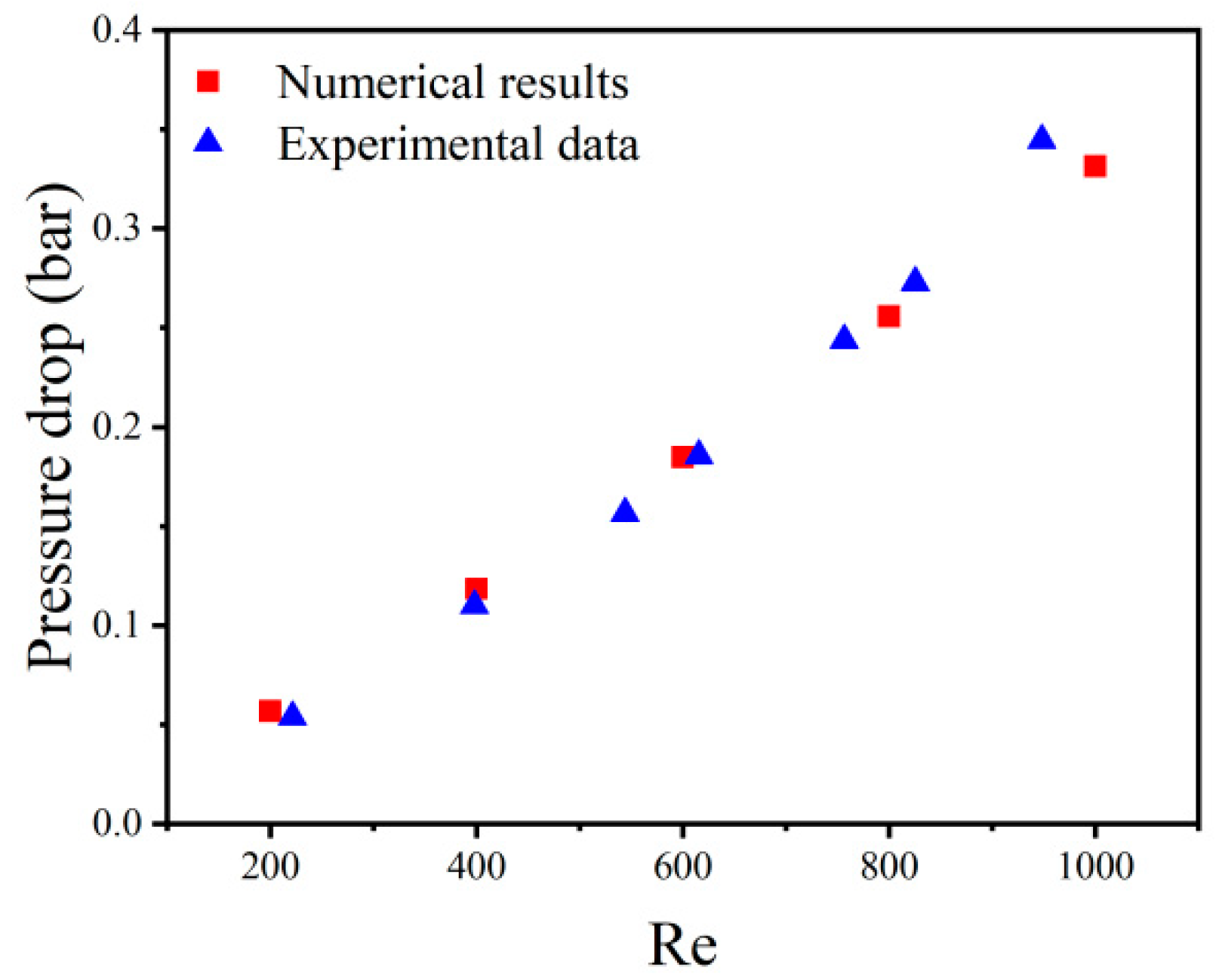


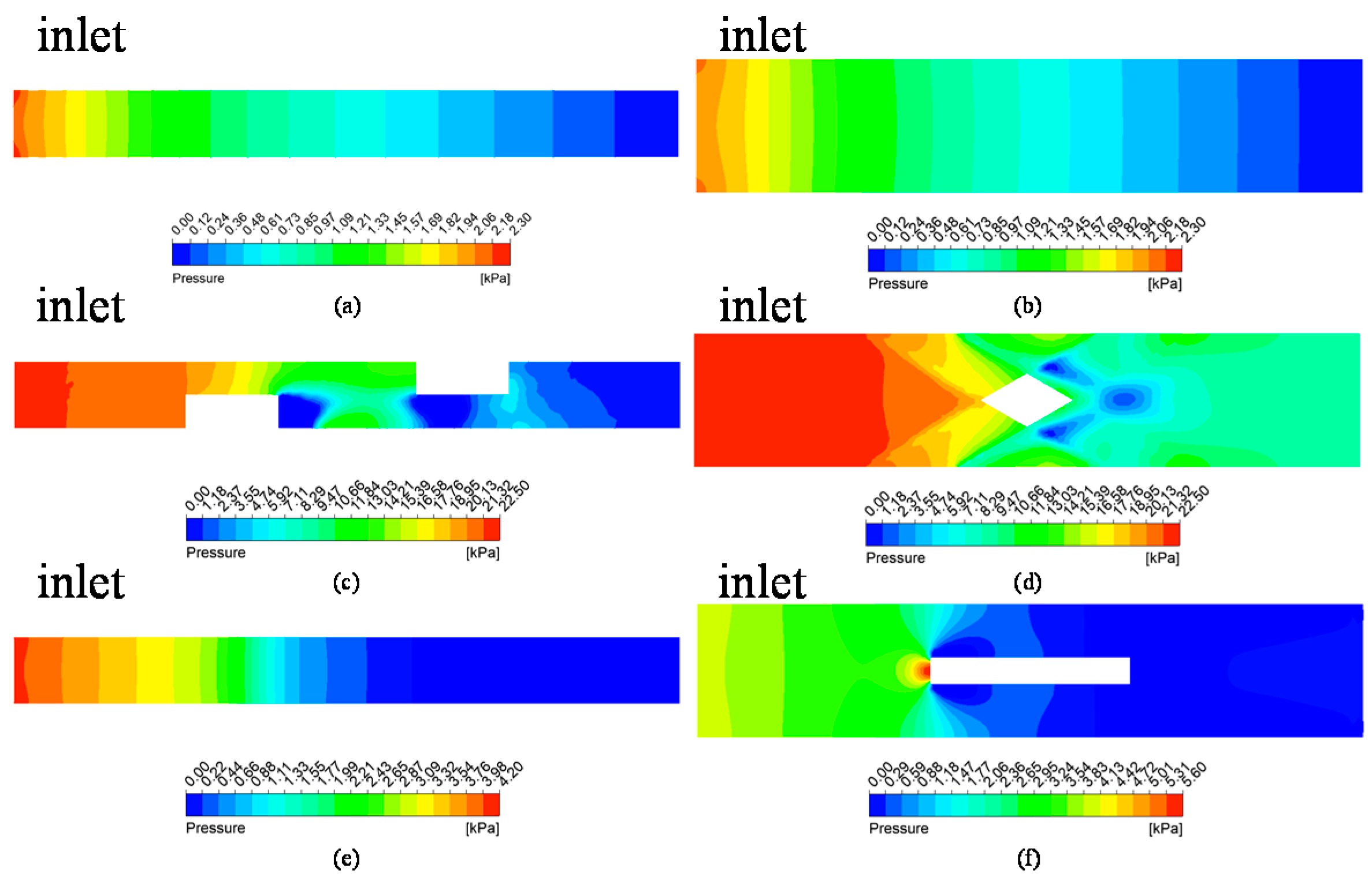
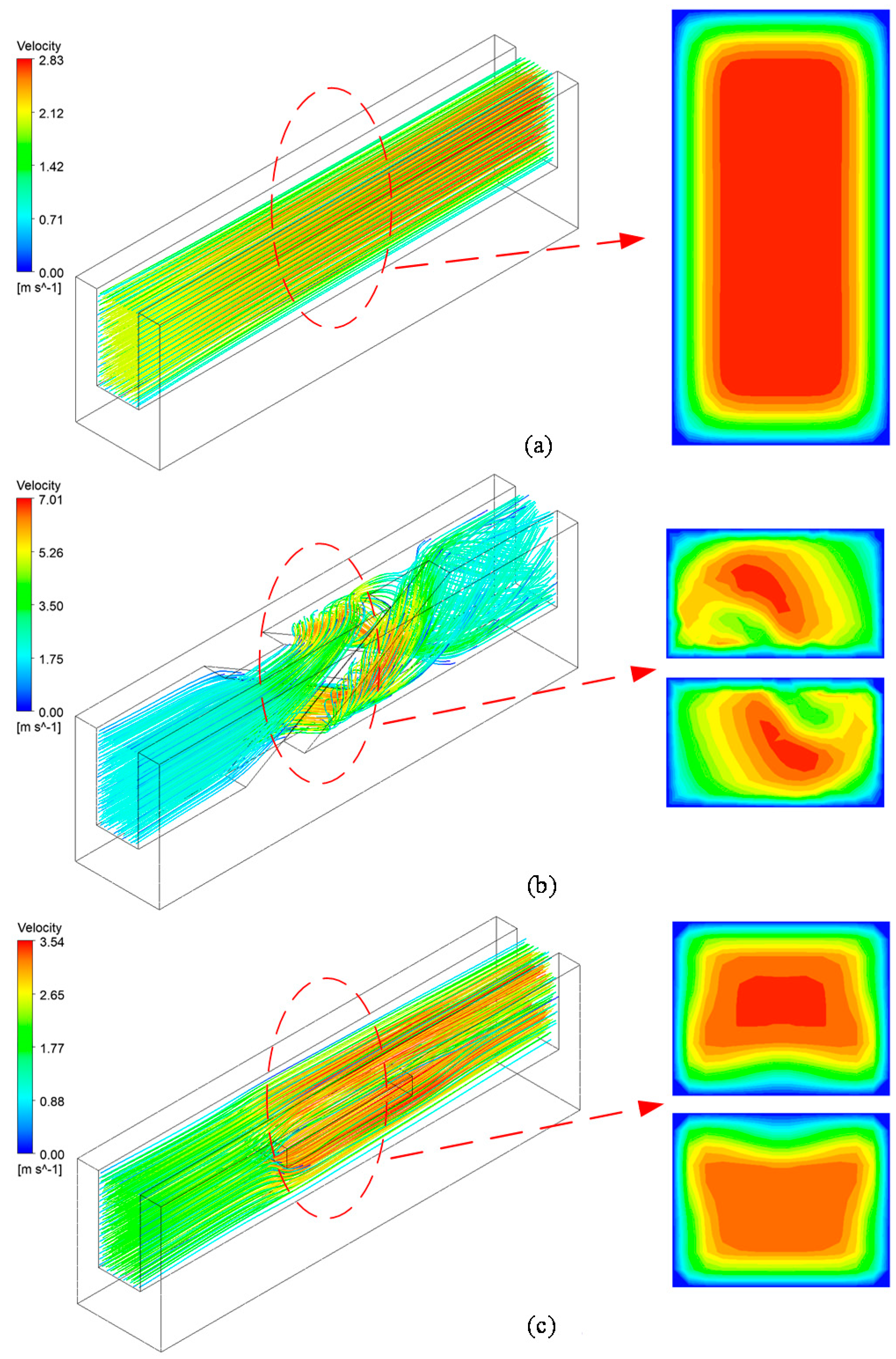
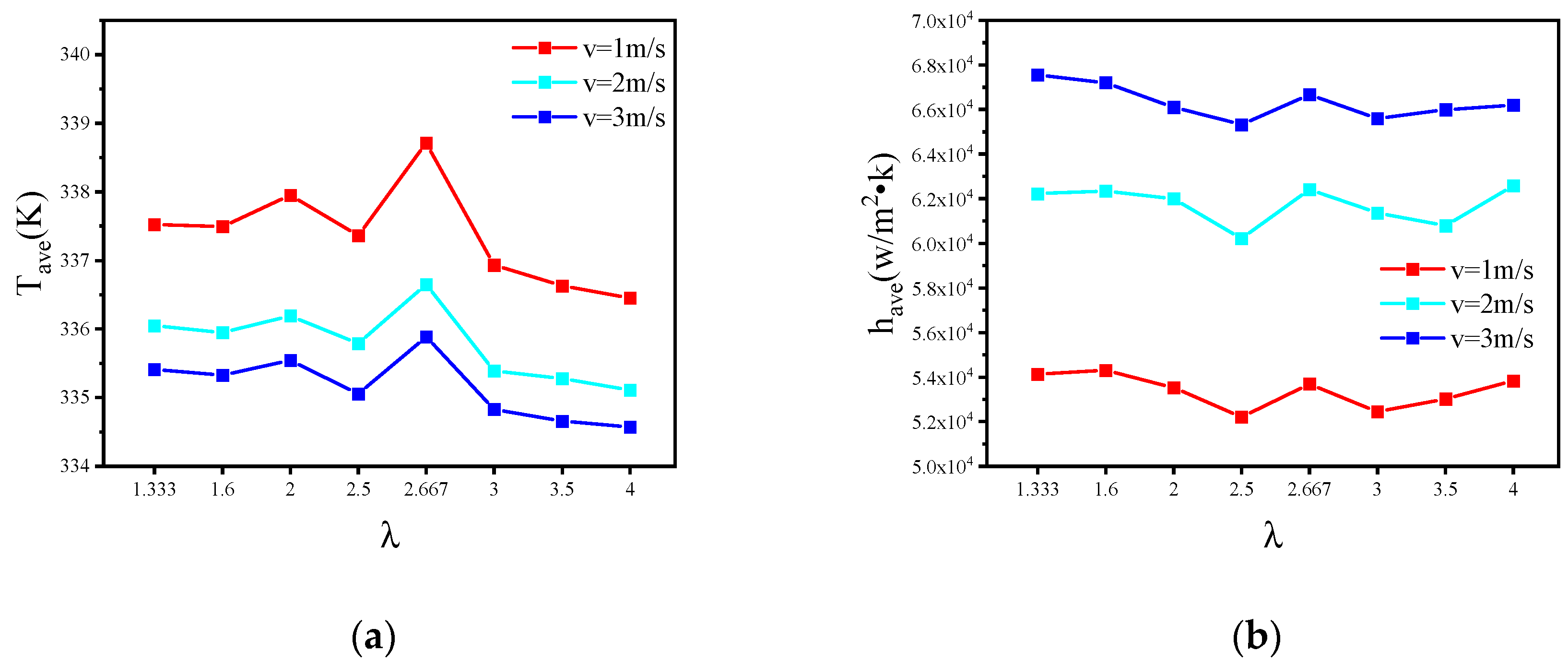
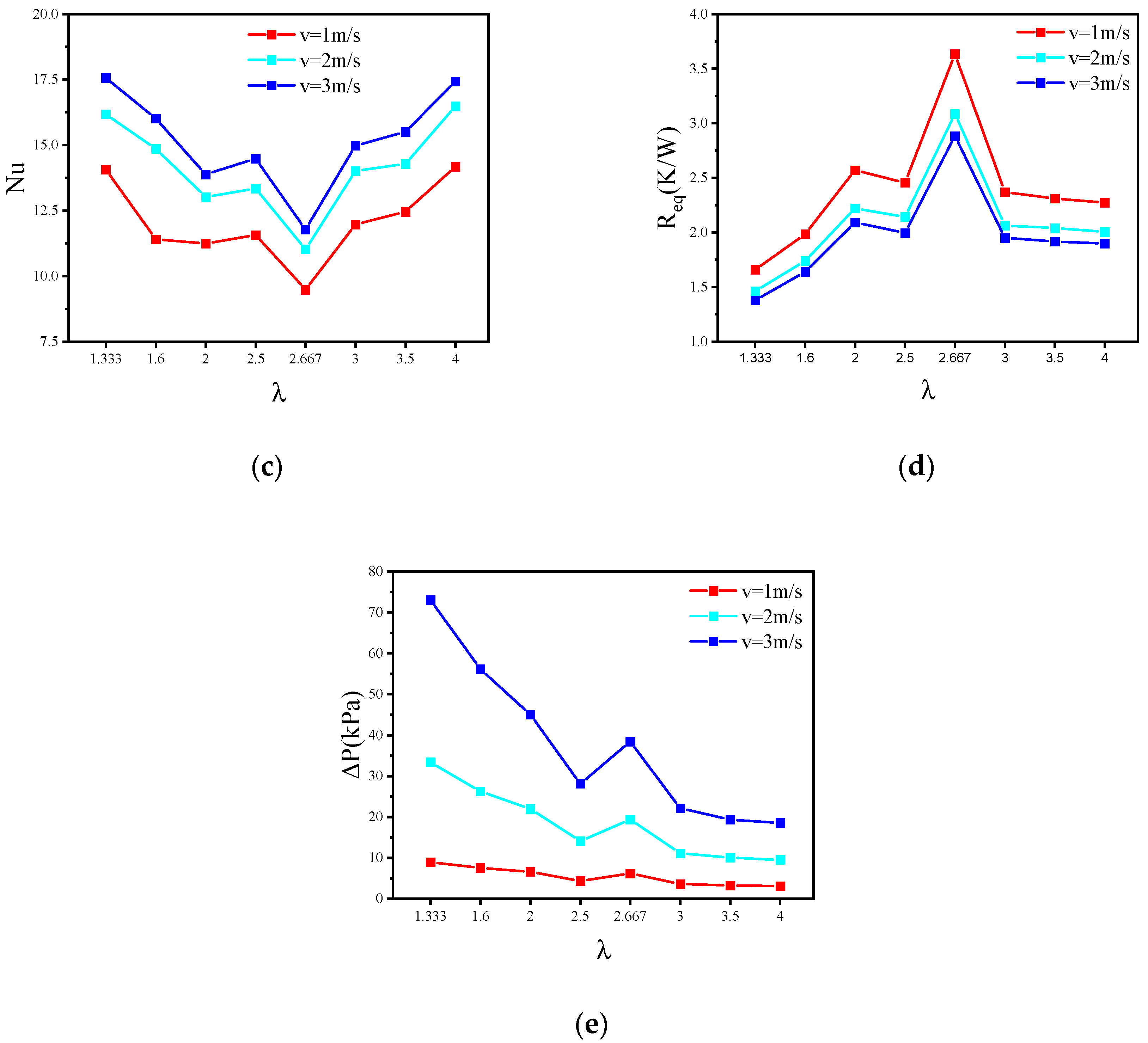
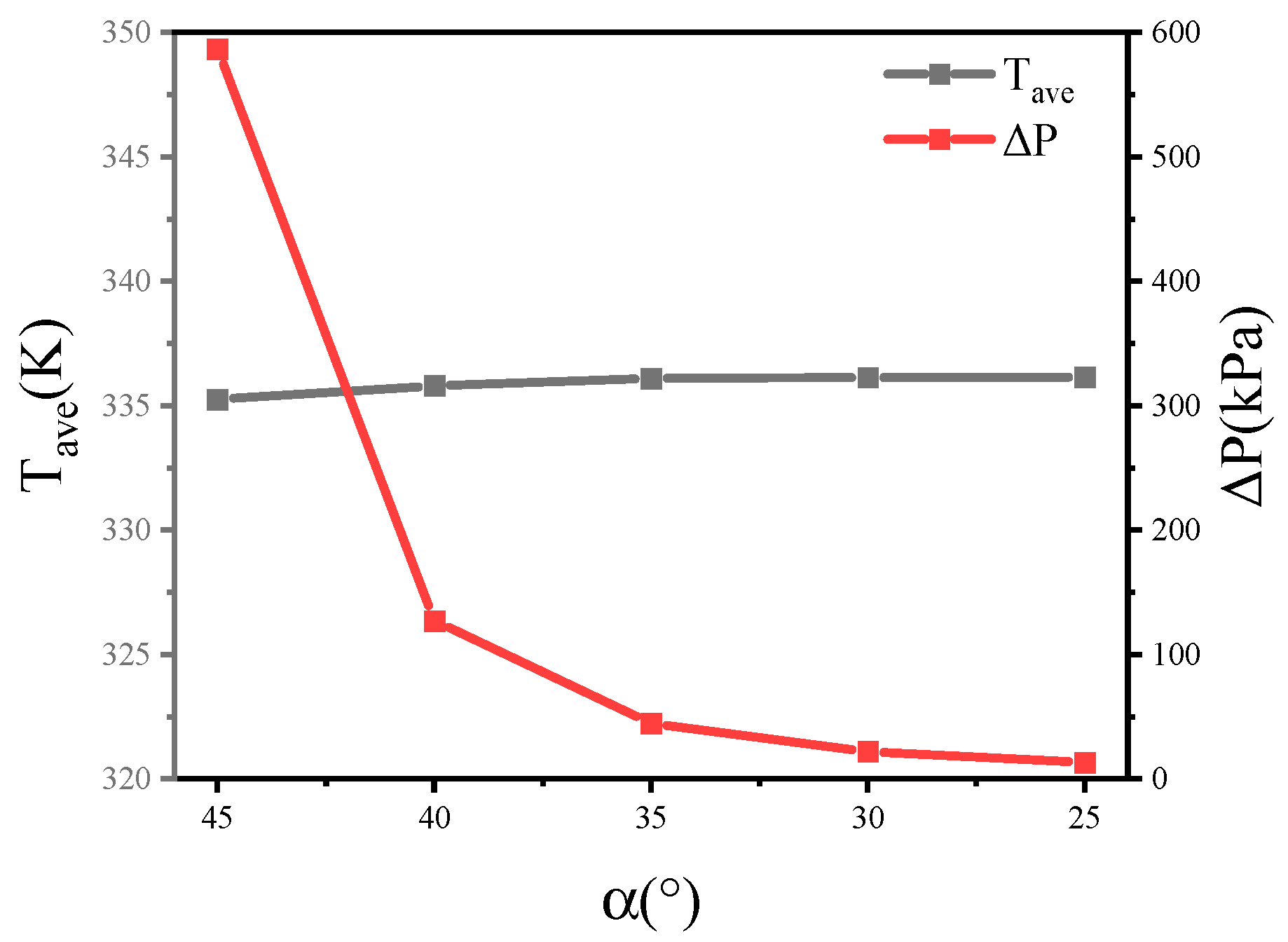
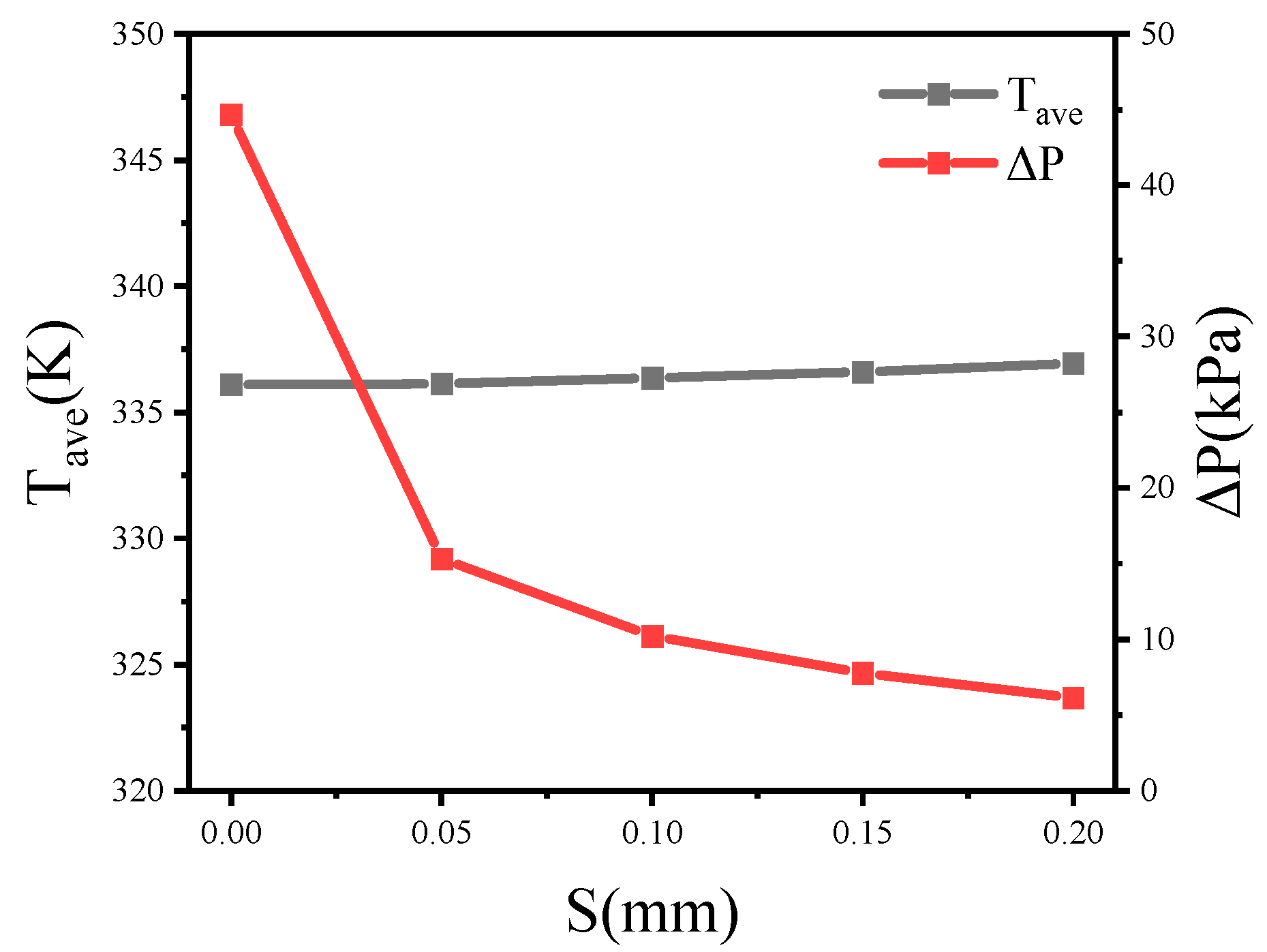
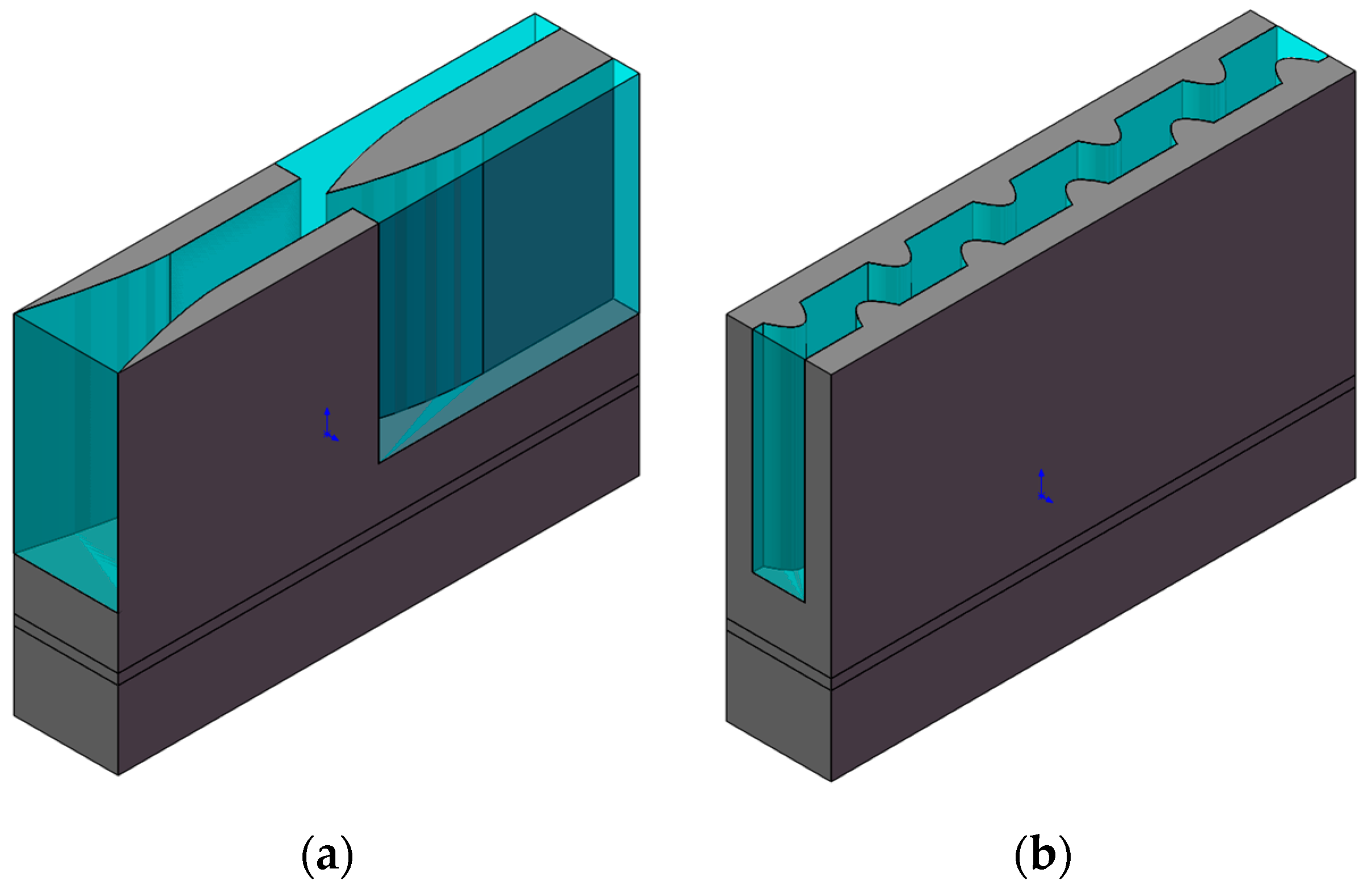
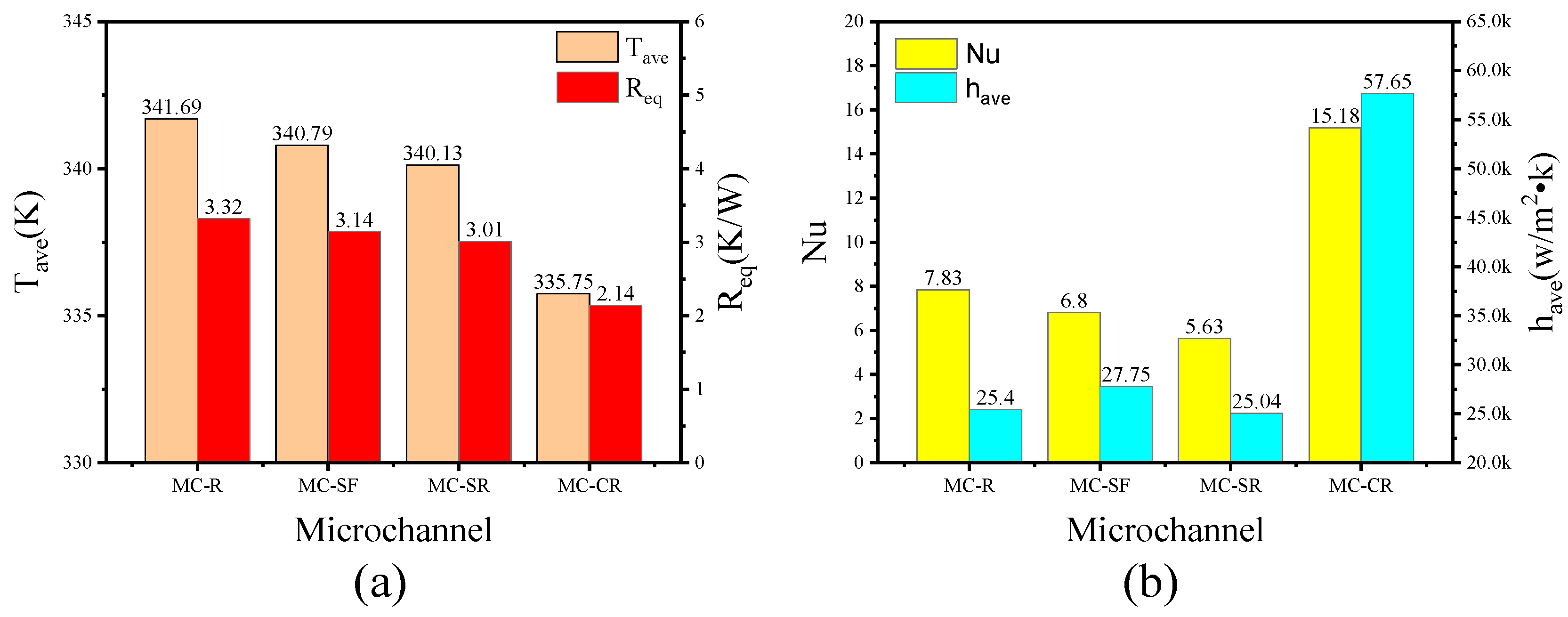
| Parameter | Dimension | Parameter | Dimension |
|---|---|---|---|
| L | 5 mm | H | 1.5 mm |
| W | 1 mm | Hch | 0.75 mm |
| Wc | 0.5 mm | Hc | 1 mm |
| Wm | 0.25 mm | Ht | 0.1 mm |
| W_HR | 0.2 mm | L_HR | 1.5 mm |
| α | 30° | S | 0 |
| Method | I | II | III | IV | V |
|---|---|---|---|---|---|
| Minimum unit size (mm) | 0.1 | 0.08 | 0.06 | 0.04 | 0.02 |
| Grid number | 11,500 | 23,751 | 55,029 | 187,500 | 1,504,500 |
| Temperature (K) | 360.771 | 356.880 | 353.179 | 351.128 | 351.576 |
| No | Hc | Wc | λ(Hc/Wc) |
|---|---|---|---|
| 1 | 1 | 0.75 | 1.333 |
| 2 | 1 | 0.625 | 1.6 |
| 3 | 1 | 0.5 | 2 |
| 4 | 1.25 | 0.5 | 2.5 |
| 5 | 1 | 0.375 | 2.666 |
| 6 | 1.5 | 0.5 | 3 |
| 7 | 1.75 | 0.5 | 3.5 |
| 8 | 2 | 0.5 | 4 |
Publisher’s Note: MDPI stays neutral with regard to jurisdictional claims in published maps and institutional affiliations. |
© 2022 by the authors. Licensee MDPI, Basel, Switzerland. This article is an open access article distributed under the terms and conditions of the Creative Commons Attribution (CC BY) license (https://creativecommons.org/licenses/by/4.0/).
Share and Cite
Chen, H.; Chen, C.; Zhou, Y.; Yang, C.; Song, G.; Hou, F.; Jiao, B.; Liu, R. Evaluation and Optimization of a Cross-Rib Micro-Channel Heat Sink. Micromachines 2022, 13, 132. https://doi.org/10.3390/mi13010132
Chen H, Chen C, Zhou Y, Yang C, Song G, Hou F, Jiao B, Liu R. Evaluation and Optimization of a Cross-Rib Micro-Channel Heat Sink. Micromachines. 2022; 13(1):132. https://doi.org/10.3390/mi13010132
Chicago/Turabian StyleChen, Haiying, Chuan Chen, Yunyan Zhou, Chenglin Yang, Gang Song, Fengze Hou, Binbin Jiao, and Ruiwen Liu. 2022. "Evaluation and Optimization of a Cross-Rib Micro-Channel Heat Sink" Micromachines 13, no. 1: 132. https://doi.org/10.3390/mi13010132
APA StyleChen, H., Chen, C., Zhou, Y., Yang, C., Song, G., Hou, F., Jiao, B., & Liu, R. (2022). Evaluation and Optimization of a Cross-Rib Micro-Channel Heat Sink. Micromachines, 13(1), 132. https://doi.org/10.3390/mi13010132





